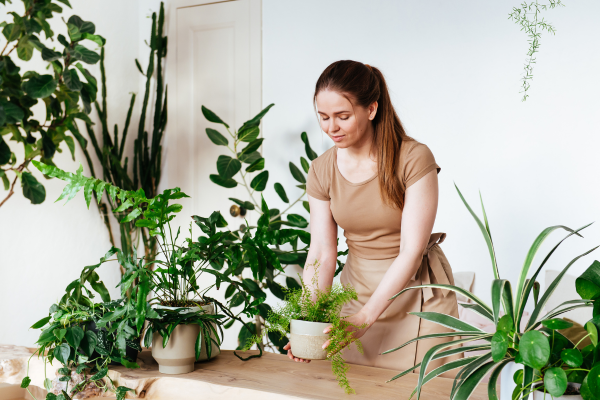Best Indoor Plants for Clean Air: Indoor air quality is a growing concern, especially as people spend up to 90% of their time indoors. From volatile organic compounds (VOCs) emitted by furniture and cleaning products to allergens like mold and dust, indoor air can be up to five times more polluted than outdoor air. Fortunately, nature offers a simple solution: air-purifying indoor plants. These green companions not only enhance your home’s aesthetics but also filter toxins, boost humidity, and even improve mental well-being.
Backed by NASA’s landmark 1989 Clean Air Study, which identified plants capable of neutralizing harmful chemicals, this guide explores the best indoor plants for clean air. Whether you’re a seasoned plant parent or a beginner, discover how to transform your living space into a healthier, fresher environment.
Table of Contents
Why Indoor Plants Matter for Clean Air
Indoor plants act as natural air purifiers through photosynthesis and phytoremediation. Their leaves absorb pollutants like formaldehyde, benzene, and xylene, while their roots and soil microbes break down toxins. NASA’s research highlighted that certain plants can remove up to 87% of airborne contaminants within 24 hours. Beyond air purification, plants release oxygen, increase humidity, and reduce stress levels.
Common indoor pollutants include:
- Formaldehyde: Found in plywood, carpets, and adhesives.
- Benzene: Emitted by plastics, synthetic fibers, and detergents.
- Trichloroethylene: Present in paints, varnishes, and aerosol sprays.
- Ammonia: Common in cleaning products.
Combining plants with proper ventilation and reduced chemical use creates a holistic approach to cleaner air.
Top 15 Air-Purifying Indoor Plants
1. Spider Plant (Chlorophytum comosum)

Benefits: A champion against formaldehyde, carbon monoxide, and xylene. Safe for pets and resilient in low light.
Care Tips: Thrives in indirect sunlight; water when soil dries. Produces “spiderettes” that can be propagated.
Air-Purifying Qualities: Removes 95% of formaldehyde in 24 hours (NASA study).
2. Snake Plant (Sansevieria trifasciata)

Benefits: Filters benzene, formaldehyde, and nitrogen oxides. Releases oxygen at night, ideal for bedrooms.
Care Tips: Low light tolerant; water sparingly (overwatering causes root rot).
Air-Purifying Qualities: Removes 52.6% of benzene in sealed chambers.
3. Peace Lily (Spathiphyllum spp.)

Benefits: Combats ammonia, benzene, and mold spores. Boosts humidity by up to 5%.
Care Tips: Keep soil moist; thrives in shade. Note: Toxic to pets if ingested.
Air-Purifying Qualities: Neutralizes all three major VOCs (formaldehyde, benzene, trichloroethylene).
4. Boston Fern (Nephrolepis exaltata)

Benefits: Excellent at removing formaldehyde and xylene. Acts as a natural humidifier.
Care Tips: Requires high humidity and indirect light; mist regularly.
Air-Purifying Qualities: Eliminates 1,863 micrograms of formaldehyde per hour.
5. Bamboo Palm (Chamaedorea seifrizii)
Benefits: Targets benzene, formaldehyde, and trichloroethylene. Adds tropical flair to large spaces.
Care Tips: Prefers bright, indirect light; keep soil consistently moist.
Air-Purifying Qualities: Scores 8.4/10 in NASA’s air purification rating.
6. Aloe Vera (Aloe barbadensis miller)
Benefits: Clears formaldehyde and benzene. Soothes burns with its gel.
Care Tips: Needs bright sunlight; water deeply but infrequently.
Air-Purifying Qualities: Acts as an air quality indicator (brown spots signal high toxin levels).
7. English Ivy (Hedera helix)

Benefits: Reduces airborne mold by 94% and filters benzene. Perfect for bathrooms.
Care Tips: Prefers moderate light and cool temperatures; prune regularly.
Air-Purifying Qualities: Removes 7.8 µg/m³ of benzene in 24 hours.
8. Rubber Plant (Ficus elastica)

Benefits: Tackles formaldehyde, especially in rooms with synthetic carpets.
Care Tips: Tolerates low light; wipe leaves to enhance photosynthesis.
Air-Purifying Qualities: Removes 47% of formaldehyde in controlled environments.
9. Dracaena (Dracaena spp.)

Benefits: Filters benzene, formaldehyde, and trichloroethylene. Varieties include ‘Janet Craig’ and ‘Warneckii.’
Care Tips: Avoid direct sunlight; keep away from pets (toxic if ingested).
Air-Purifying Qualities: Eliminates 70% of benzene within 24 hours.
10. Golden Pothos (Epipremnum aureum)

Benefits: Neutralizes formaldehyde, carbon monoxide, and toluene. Fast-growing and low-maintenance.
Care Tips: Thrives in low light; let soil dry between waterings.
Air-Purifying Qualities: Removes 73% of benzene in controlled studies.
11. Chinese Evergreen (Aglaonema spp.)

Benefits: Filters benzene, formaldehyde, and trichloroethylene. Thrives in dimly lit rooms.
Care Tips: Prefers high humidity; water moderately.
Air-Purifying Qualities: Reduces VOC levels by 50% in 4 weeks.
12. Gerbera Daisy (Gerbera jamesonii)

Benefits: Removes benzene and trichloroethylene. Bright blooms boost mood.
Care Tips: Needs direct sunlight; water at the base to avoid mold.
Air-Purifying Qualities: Eliminates 67% of benzene in 24 hours.
13. Areca Palm (Dypsis lutescens)

Benefits: Humidifies air and removes formaldehyde, xylene, and toluene.
Care Tips: Mist frequently; place in bright, indirect light.
Air-Purifying Qualities: Scores 8.5/10 in NASA’s efficiency ratings.
14. Philodendron (Philodendron spp.)
Benefits: Targets formaldehyde, prevalent in insulation and glues.
Care Tips: Easy to grow; avoid overwatering. Toxic to pets.
Air-Purifying Qualities: Removes 86% of formaldehyde in 24 hours.
15. Flamingo Lily (Anthurium andraeanum)

Benefits: Filters ammonia, formaldehyde, and xylene. Striking red blooms add color.
Care Tips: Requires high humidity and indirect light; keep away from pets.
Air-Purifying Qualities: Reduces ammonia by 10% in small spaces.
How to Maximize Air-Purifying Benefits
- Quantity Matters: Aim for at least one plant per 100 square feet.
- Strategic Placement: Position plants in high-traffic areas (living rooms, kitchens) and bedrooms.
- Healthy Plants, Cleaner Air: Remove dust from leaves, avoid overwatering, and use organic fertilizers.
- Combine Methods: Use air purifiers, open windows, and reduce synthetic products.
Conclusion
Indoor plants are a natural, cost-effective way to combat air pollution while enhancing your home’s ambiance. From the hardy Snake Plant to the vibrant Gerbera Daisy, each species offers unique benefits. While plants alone can’t eliminate all pollutants, they play a vital role in a holistic clean-air strategy. Start with a few low-maintenance varieties and gradually build your indoor garden—your lungs (and mind) will thank you.
By integrating these air-purifying plants into your living space, you’re not just decorating—you’re investing in a healthier, greener future.
References
https://www.hgtv.com/design/remodel/interior-remodel/10-best-plants-for-cleaning-indoor-air-pictures


